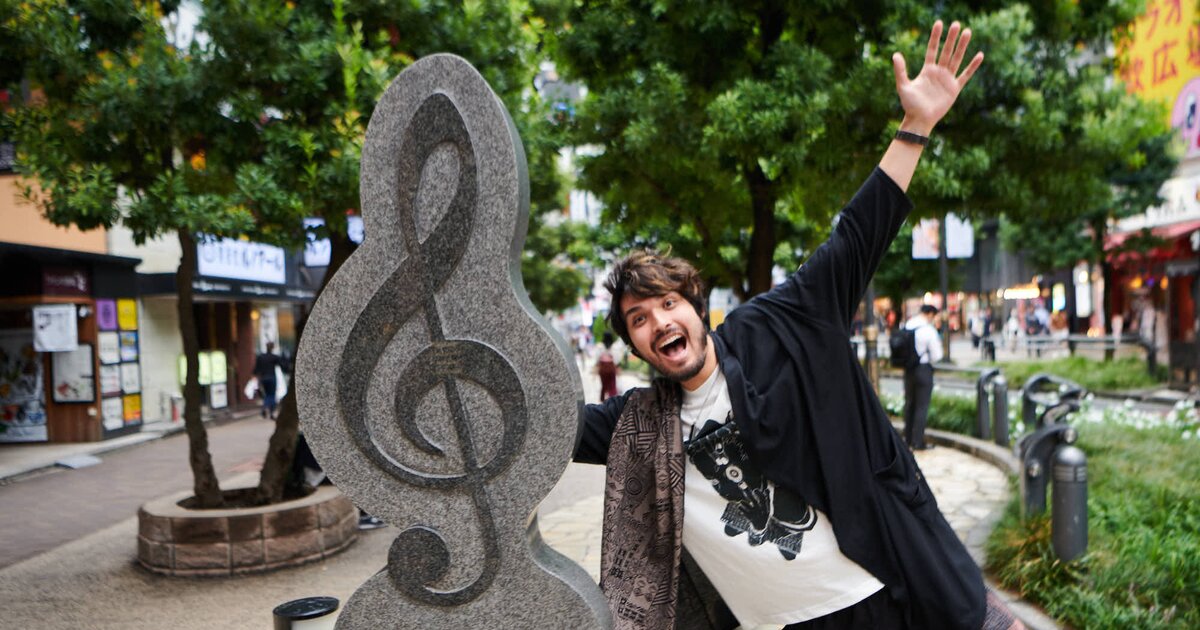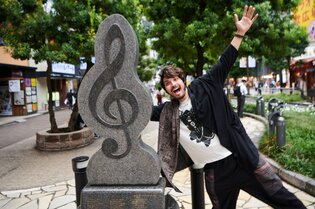

When you’re planning a trip to Tokyo, the countless travel recommendation lists are overwhelming. There are lists for shopping, lists for eating, lists for sightseeing… and not to mention, lists for otaku. But what does The Anime Man himself recommend? One of our staff members sat down with him and asked him what he thinks of being an anime fan in Tokyo and what any otaku visiting should try.
Tokyo Otaku Mode: Thank you for sitting for this interview with us. Let’s get started with a fairly simple question. When you think of anime based in Tokyo, what are some of the ones that come to mind?
The Anime Man: Immediately, I’m going to call myself out and pigeonhole myself in a certain generation of anime-watchers, but one that made me interested in going around a certain part of Tokyo was an anime called Durarara!!, based on a light novel by Narita Ryohgo. It was an amazing anime series based in Ikebukuro that I grew up watching. I would have my iPod on and I’d walk around, listening to the opening themes of the show while going to the very notable places like the highway that travels across east Ikebukuro. I’m like “oh, that’s where Celty rode her bike!” So that was really cool.
Another one that people will end up going to a lot is Shibuya. There are a lot of manga and anime that are based in Shibuya, but one that really stuck with me was a game called Persona 5, which also has an anime adaptation. It’s not set just in Shibuya, but a lot of it is, including certain train lines and buildings that actually exist. It’s fun to listen to that amazing soundtrack while walking around and pretending I’m the main character. The cool thing about Persona 5 is that it’s not just Shibuya, but all over Tokyo. There are certain parts where the characters go to Tsukishima and have monjayaki (a pan-fried batter-based dish that Tsukishima is famous for), Ogikubo to eat ramen, and Nakano to shop. Sangenjaya is the main hub for that series, even though it’s called Yongenjaya in the game (which I thought was a real place, but turned out it’s not).
Going outside the major areas of the city, one that was really memorable for me is this place called Hakonegasaki because it’s based on one of my favorite anime ever, Clannad. It’s on the outskirts of Tokyo prefecture, about an hour west of Shinjuku by train. It holds a special place for me because it’s one of the first real-life locations in anime I ever went to. Not only was an anime I freaking adore based there and the scenery is absolutely beautiful, but it also gave me an amazing glimpse into the non-city part of Tokyo that a lot of people who visit Japan don’t have the time or interest to go to see. Hakonegasaki was great for me because I’d never been anywhere close to that part of Tokyo before. That part of Japan has a kind of somber beauty that I never expected to see in Tokyo, so it made me appreciate the aspects of environments that are present within the prefecture. It was a lot of fun. It was very emotional for me to see a lot of those spots that were in Clannad because it was one of the few anime that made me cry like an absolute baby, so reliving that in real life and putting myself in that spot where a character I liked once stood was really cool as a fan and now is an unforgettable memory.
TOM: We get a lot of countryside shots in anime where you see a lot of scenery like the tea or rice farms, just fields of rolling green, and a lot of people don’t realize that you can see that in Tokyo. All you need to do is take the train out an hour or two.
TAM: Yeah, you don’t need to take the bullet train or a domestic flight to see these places. Tokyo is really interesting in that a lot of people forget that there are a lot of mountainous, countryside parts because when you think Tokyo, you think of a huge city with 30 million people where everything happens in this central hub. But actually, if you take the time to just venture out a little bit, especially out toward the west, then you’ll find some absolutely incredible scenery. Okutama is one of the places I absolutely love going to because it is so close to central Tokyo but it’s a completely different view. That juxtaposition of those two different environments in such a small place goes to show how small yet dense the country is with the variety of different places you can go to.
TOM: You mentioned that you’d walk around Ikebukuro with your headphones, listening to the Durarara!! soundtrack. Do any other memories stand out from your life when you think of experiences that are related to other Tokyo-based anime?
TAM: Tokyo is such a cool place for an anime fan. It might not have as many real-life locations from anime as outside of Tokyo, but because it’s a central hub you can find anything and everything related to anime and the subcultures surrounding it within a short space. The first time I discovered big anime stores and underground hidden stores that sell otaku merchandise was a revelation to me. It was like stumbling upon El Dorado or when you unlock a new map in a game. It made me feel like, “Why did no one tell me this existed? Now I have an entirely new area to explore that fits my needs!” Tokyo is the gift that keeps on giving when it comes to that. I’ve been here for 7-8 years and I still find new things to do in Tokyo, whether they’re anime-related or not. I’m still finding new stores for specific niches in otaku culture and I think Tokyo has everything surrounding that subculture.
TOM: If you could recreate a scene from an anime based in Tokyo, which one would you pick and why?
TAM: One that I haven’t yet done that I would like to eventually is the final staircase in Your Name. I think every Shinkai fan who comes to Tokyo is like, “Where is that staircase? I need to find that staircase. I need to bring along my friend and recreate that scene!” because it’s so pivotal and beautiful. I just haven’t had time to figure out which of the billions of staircases in Tokyo it is. It’s not a grandiose or touristy spot, but it’s something a little more subtle that does have the vibe of Japan and anime. I think that’s why it’s recreated so often by tourists because it’s easy to do and it’s instantly recognizable. If you can get the shot, it’s also a great photo, so win-win.
-----
Tokyo Anime Spot Guidemap profiles locations from anime productions set in Tokyo.
Discover Tokyo anew as you navigate your way to “sacred sites” from the list of Japanese Anime 88-Spots (2023 Edition), a collection of real-life locations featured in anime productions. Visit the Guidemap website for more information here.
{pagebreak}

TOM: It’s in the middle of a random residential area, so now that authenticity is something people are seeking in their travels, looking to recreate shots like that is one way to learn how people really live.
TAM: That’s another thing that I tell a lot of people who come to Japan for the first time. There’s nothing wrong with just walking through a residential area because that gives you a real-life perspective of how people live. It may not be a place where lots of interesting things are going on, but I always enjoy walking through residential areas because it gives me a broader perspective of how people are living in this country.
TOM: In Japan, the back alleys are where you see the coolest little hidden stores and restaurants, like bookshops that have been there for decades that I’d love to discover as a tourist. So, in that vein, where would you recommend that fans who have never been to Tokyo before go?
TAM: I have my personal preferences, but anime fans should go to Akihabara as it’s the mecca for weebs. It’s full of so much anime that it’s a sensory overload, but in a good way. Speaking of small hidden stores that have been around for a long time, Akihabara is the pivotal place for them, especially around the backstreets. It has a good mixture of new and old. There are still plenty of remnants of when it was called “Electric Town,” but now I feel like it’s more of an “Anime City.” If you’re an anime fan and you’ve been to Japan but not to Akihabara, can you really call yourself an anime fan? It’s a rite of passage for otaku to go to Akihabara.
I personally frequent Nakano Broadway more than Akihabara nowadays because I prefer its traditional old-school style. In general, there are fewer people and more interesting stores that are immediately accessible. Akihabara has more variety and some cool, unique stores but they also take a little more effort to find, so if you’re short on time, then Nakano Broadway is much more cut and dry since it’s simply four floors of accessible shops. My current favorite store there is one that sells nothing but cels (transparent materials used to make frames in traditional animation) from old anime so you can rummage through them and see if you can find your favorite scene or character. Having that original cel is a very nerdy thing to get excited about, but it’s a different way to enjoy anime. There are also a lot of older subculture-based stores in Nakano Broadway, such as some that feature kaiju and tokusatsu culture, so I always recommend checking them out. Obviously, Shinjuku, Shibuya, Ueno, and Asakusa are all obvious must-sees. Another place that I like to recommend to people is Odaiba. It’s a little out of the way, but it’s one of the few places where you can experience what an ocean view is from Tokyo. There’s also the giant Gundam statue which is pretty dope even if you’re not a Gundam fan.
TOM: I enjoyed Nakano Broadway, but I prefer Ikebukuro to go down Otome Road, personally, since it caters more to women. So, where would you recommend for those who have been to Tokyo multiple times and have done the Akiba and Odaiba scenes before?
TAM: I would say explore outside of the 23 wards in Tokyo, like Okutama and Mitaka for the Ghibli Museum. West Tokyo is a very unexplored area that a lot of visitors don’t realize is full of amazing places to see. Ogikubo has a lot of great food places, and a lot of the anime studios are based out there. If you keep going west, you can get more of the freeing outdoorsy breezy country life, but it’s also not so country that it becomes inaccessible. A lot of it are built-up towns that just aren’t huge cities. I was born and raised in that kind of place, so I love it. The big city is always great, but especially with Tokyo, there is so much more than the city. Even within the city, there are quiet spots you can go to, such as all of the incredible parks here. The number one thing I always tell people is to just walk everywhere. That is the best way to find a ton of cool things in Tokyo. You’ll miss so much if you’re on a train or in a car. Don’t even open a map. Just walk in a direction that you feel is the correct path and see what you can find. I do that as a hobby on my days off and I’ve found some amazing hidden locations that way. That’s the most authentic way you can experience the inner workings of Tokyo.
TOM: What are some of the great things you’ve been able to experience in Tokyo as an anime fan?
TAM: Because Tokyo is such a massive hub, literally every kind of event or store is always available. There is always something going on that is anime-related. Museums in Roppongi often have big anime exhibits, and I went to the Attack on Titan and the EXHIBITION of PRETTY GUARDIAN SAILOR MOON (2016) there. The museum exhibits are constantly changing, but there’s always something going on that’s anime-related around those parts. Another thing that Japan does well is collaboration cafes. There are a ton of places in Shibuya, Shinjuku, and Ikebukuro that are event locations where they just go, “Okay, for the next two weeks here’s a Jujutsu Kaisen or Demon Slayer cafe, and you can get exclusive merch there.” You know, when anime fans hear the term “exclusive merch,” they start foaming at the mouth. That’s bragging rights for a lot of weebs, so regardless if the food is good, it’s still a good time. Another thing that gets anime fans really giddy is walking around a random place and spotting anime girl posters or ads for your favorite or upcoming anime. It’s not just in Akihabara. There are little bits and tastes of anime in regular life. Anime is such a normal thing that has been integrated into society in Japan. Japanese McDonalds recently came out with an ad that was an anime and the weebs were like “I never thought an ad would make me want to work at McDonalds, but this did!” I feel that it’s so commonplace in Tokyo and Japan that it gets people excited when they first get here.
TOM: There’s also the fact that Japan is so otaku-friendly. In Shibuya and Shinjuku Stations, there are these huge walls that are used for ads specifically because they know people are going to make their way over there to see it and take pictures of it.
TAM: There was a construction site in Shibuya where the white barriers around the site were covered in beautiful art from the Akira movie. I didn’t know about it beforehand. I just found it when I was randomly walking around Shibuya, and it blew my mind. I took a ton of photos. So if you go out and explore, you might stumble upon something really cool that is anime-related. It’s that joy of mystery that keeps anime fans coming back to look around.
-----
Tokyo Anime Spot Guidemap profiles locations from anime productions set in Tokyo.
Discover Tokyo anew as you navigate your way to “sacred sites” from the list of Japanese Anime 88-Spots (2023 Edition), a collection of real-life locations featured in anime productions. Visit the Guidemap website for more information here.
{pagebreak}

TOM: What sort of otaku-related events do you like to go to?
TAM: A lot of the exhibits and museums I like going to are those that highlight a particular series where they display the original artworks or celworks. Going to those is always fun. I’m one of those anime fans who love collecting exclusive artworks, to the point that I have a wall in my room just covered in them. Places like that are really cool because going to those kinds of exhibits gives you a whole new level of appreciation of this series that you enjoy that you can’t get anywhere else. You can read the same manga or watch the same anime a hundred times, but it isn’t until you go to one of these museums that you go, “Wow, this is crazy.” It gives you a whole new relationship with how you view this piece of art. It’s always a great feeling as a fan of a particular show.
I’m a massive music nerd, so I also love to go to concerts by bands that I found through an anime opening or ending. I know for international audiences, that’s a big way that people discover Japanese bands. Like, I’m sure everyone found Asian Kung-fu Generation from shows like NARUTO. The concert culture in Japan is so unique and fun. If the timing is right, you can go see the band that played your favorite anime songs. When they play that song, it’s hype as hell.
TOM: I went to the My Hero Academia and Card Captor Sakura exhibits at the Mori Art Museum, and something that stood out to me was seeing the notes that they would leave their assistants. It really makes you think about how the art that you enjoy is created.
TAM: It is something that takes a lot of time and work from a lot of people. It takes a lot of planning. It should give anime fans a whole new level of patience when it comes to the next installment, since it isn’t something that is made by one person overnight. The EXHIBITION of PRETTY GUARDIAN SAILOR MOON (2016) was one of the first exhibits I ever went to because I watched it growing up and read all of the manga. (Though at the exhibit, I was the only non-Japanese male and I got very weird looks!) Seeing the details of how Naoko Takeuchi made the manga and the inner workings of the series made me think, “If this is like that, then every anime must be like this on varying levels.” There’s so much time and money sunk into it. It made me think about whether there was a way for me as a fan to be able to support that in any way, whether it be monetarily or by doing “activism” to urge people to support the artists behind their favorite anime. It reinforced my desire to shoot the message out to my audience on my channel to think about what we as fans can do. Instead of complaining about how long things are taking, one of the most respectful things we can do as fans is to be patient.
TOM: Going back to the music thing, a lot of people don’t realize that a lot of the bands that are chosen for anime songs aren’t necessarily huge. A lot of them are actually pretty indie. Tokyo has a ton of music venues, so it is extremely possible for a traveler to find a concert going on of a group they’ve heard of while they’re in town, so I think that was a good point as well. This is similar, but do you keep an eye out for pop-up, limited events?
TAM: Definitely. It depends on what the series is or if I have a huge fascination with it. One that I fought tooth and nail to go to was the final Berserk exhibit that opened after Miura Kentaro passed away. That’s one of my favorite manga series of all time and one of the best fictional stories ever written. I was going to that exhibit whether it killed me, and it gave me an entirely new level of appreciation for Miura and his work and the sheer effort that went into it. My favorite thing about going to this kind of event is that you get this reassurance when you see other people that’s like, “Oh, I’m not the only one who loves this show.” It’s a shared thing and you get this sense of community. For a long time, especially in the early days of the Internet, a lot of people have worried whether they’re the only ones who like this stuff. In the past five to ten years, it’s gotten very commonplace, but before that, it wasn’t, so it’s reassuring for an anime fan to know you’re not the only one.
TOM: Going to Ikebukuro and seeing just cosplay stores where you can walk in and buy whole outfits, but when I was a teenager, I just had to cobble it together from thrift stores, so those shops blew my mind.
TAM: Totally. That’s a great point. Cosplay culture is all over Tokyo. You can find affordable cosplay studios very easily. A lot of them are English-friendly, and you can go with your own outfit from home or one you picked up while in Tokyo. So if you want to have a photoshoot while you’re in Tokyo, that’s totally doable and acceptable. It’s a lot of fun and it’s a great way to immerse yourself in the culture.
TOM: What do you think is the fun part about checking out anime-related spots?
TAM: What I really enjoy is getting into the heads of the people who decide on the locations of these places. For example, I understand that Ikebukuro is the place for Durarara!!, but why? Why did he decide to set it in Ikebukuro, of all places? Going there gives you a new perspective and understanding of the show you love, but it’s also an excuse to see every nook and cranny of these locations. People who come to Tokyo often stop at the top ten tourist locations, but a lot of the scenes recreated in its anime counterpart aren’t necessarily the touristy places. It’s usually on the outskirts or in off-beat places, like nondescript streets, corners, buildings. I used to do this thing where I’d have my phone in one hand with a screenshot from an anime and hold it up to align it with the street itself. There’s a level of euphoria in that moment where everything clicks together. Taking the photo and comparing it to real life, putting myself in that scene, really made me feel like I was in that show. And if you’re a fan, what more could you want?
-----
Tokyo Anime Spot Guidemap profiles locations from anime productions set in Tokyo.
Discover Tokyo anew as you navigate your way to “sacred sites” from the list of Japanese Anime 88-Spots (2023 Edition), a collection of real-life locations featured in anime productions. Visit the Guidemap website for more information here.
{pagebreak}

TOM: What kind of anime-related spots have you been to?
TAM: A while ago on my channel I had a mini-series called Anime in Real Life where I would go to locations of shows I really like or locations that had a ton of anime based on it. It was an excuse to show all kinds of Tokyo sights to my fans, but also I knew that people interested in the show would watch the video because I would go to all the places located in the show. It’s a great excuse to see different sides of Tokyo.
TOM: Are there any places in recently aired anime that you’d like to visit?
TAM: I haven’t watched a lot of recent anime. That’s my first problem. Well, a lot of Weathering with You was based in Shinjuku and other parts of the city, but the problem with going to places in a story like Weathering with You is that it’s not quite the same unless the whole city is flooded. You don’t get the same sight that you were hoping for. Shinjuku is one of the densest places in Tokyo, if not the world, so even I haven’t fully explored every nook and cranny. I think going up one of the tall buildings in Shinjuku to get a birds-eye view like the scenes in the movie would be a great experience to see Shinjuku from that angle.
TOM: That’s a great idea. I was thinking of BOCCHI THE ROCK! in Shimokitazawa.
TAM: I frequent Shimokitazawa because I play music. The last time I went to Shimokita was with a friend who had never been, but he wanted to buy a guitar. There was just a crapload of posters of BOCCHI THE ROCK! and I was like, “oh, yeah! It’s based here.” That’s another cool thing about walking around Tokyo. You can achieve the reverse effect of going to a location, seeing posters of a show, and getting interested in a show that you’d never heard of or considered before. I watched BOCCHI THE ROCK! because it was based in Shimokita, and there are practically no anime set there.
TOM: I used to go to Shimokita a lot, and it was under construction for a long time. There are a lot of people who haven’t been able to come back to Japan in a long time because of covid, but if they came to Shimokita before 2019 and they watch BOCCHI THE ROCK! now, they can see just how much it’s changed since their visit. But changing topics just a bit, why do you think Tokyo specifically is the perfect place to visit for anime fans/otaku?
TAM: It’s a really concentrated city and not very big in terms of space. Compared to a lot of big cities around the world, Tokyo is super concentrated so you can visit many areas and all kinds of anime-related stores, facilities, and events, because everything is in such close proximity. But because of that, a lot of it isn’t apparent if you’re not looking for it. It really does force you to go and explore deep into the nooks and crannies of the city and I think that’s always exciting to do, especially if you are an anime fan or just a fan of Japan and really want to get to know Tokyo. You can enjoy a lot of aspects of Tokyo without necessarily hunting for anime locations, but it’s a nice cherry on top. While you’re here, you’ll realize that you can visit these spots and add them into your itinerary while you’re traveling around. It’s a great excuse to wander around the city.

TOM: Please give a message of support to people wanting to visit Tokyo.
TAM: I think if you’re a fan of manga, anime, gaming, or any kind of otaku-based subculture, Tokyo is obviously the mecca that you have to visit. You don’t need me to tell you that. It really is as magical of a place as you think it is, and probably a whole lot more. It supersedes all expectations. If you want to experience Tokyo at its best, then just remember to walk, walk, walk. Don’t look at maps and don’t worry about getting lost because it’s such a safe city. Go out and explore to your heart's content and bring out your inner child. Essentially, run out onto the playground and see what happens. Tokyo is the best place for that. Hopefully you achieve all of your weeb dreams while you’re here as well.
TOM: Thank you so much!
TAM: Thank you for the interview.
If you’re in the middle of planning your trip to Tokyo, make sure to take the Anime Man’s advice while you figure out your itinerary! And for more ideas, check out this Tokyo Anime Spot Guide Map. It’ll guide you not only to spots that were used in anime, but also spots related to anime otaku culture! Check it out here.
Check out Tokyo Tokyo, an informational website by the Tokyo Metropolitan Government which features a ton of articles on some of the hottest topics in Tokyo tourism today!



0 Comments